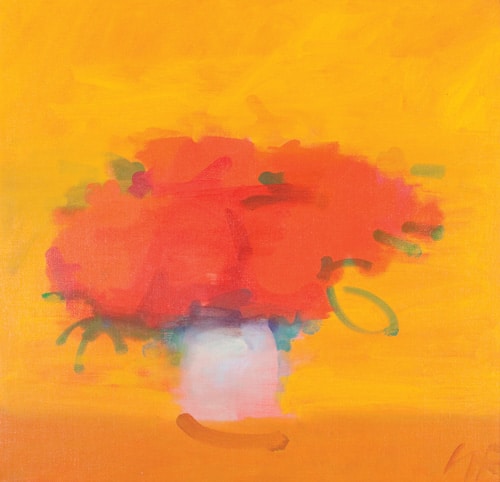Horse breaker, drover, timber cutter and rabbit shooter, typical of those with a parallel background, Sam Fullbrook’s stories were boundless and entertaining. He seemed to have a similar facade to those knockabout characters that often appear in the Cape York works by Russell Drysdale such as “Midnight Osborne” or “Rocky McCormack” but there was a double twist to Fullbrook’s character that didn’t fit into the popular ideal, Fullbrook like Drysdale was a marvellous painter, but he also had an argumentative manner.
Legend has it that some of his dealers so dreaded his appearance in their gallery so much that they would exit the back door as he came in through the front, leaving their assistants to deal with the belligerent artist that would materialize if his paintings weren’t on display. Throughout his career Fullbrook maintained a tight control on his output and struck a fine balance between the creative and the commercial needs of the art world.
Sam Fullbrook served in the Middle East and New Guinea during WWII and studied art through the Commonwealth Rehabilitation Scheme. William Dargie was his teacher and considered Fullbrook to be the star of his students “one of the best natural talents I have ever met and the only one who really understood” was Dargie’s judgement, and whose students at the time included John Brack, Fred Williams, Clifton Pugh and James Wigley.

Fullbrook’s career as a painter commenced in 1948 and to supplement his income he often returned to the outback to work as a miner or cane cutter. In the early 50’s he wandered across the continent and spent time in the North of Western Australia painting the landscape and people. He arrived in Perth in 1954 and had a substantial effect on the local art community. Laurie Thomas the director of the Art Gallery of Western Australia made the first public institution purchase of a Fullbrook with the acquisition of “The Butcher.” A number of other works were bought locally due to the efforts of Robert Juniper and such was his popularity in the west, Fullbrook held a near sell out exhibition at the Skinner Gallery in 1962.
He remained in Western Australia until 1960 working at various occupations including prospecting, fence building, mining court advocate and waterfront worker. He learnt of John Olsen’s success and returned to Sydney and also prospered. He won the Wynne Prize for landscape painting twice and in 1974 won the Archibald Prize for his portrait of the Jockey “Whopper” Stevens – he thought he owed Stevens a portrait as he (Stevens) had broken a leg when riding one of Fullbrook’s race horses.
In 1975 the Historic Memorials Committee then chaired by Malcolm Fraser and including Bill Hayden rejected Fullbrook’s portrait of Sir John Kerr. They had decided that the picture was not in keeping with the committee requirements and was in their opinion a caricature rather than a portrait. “They wouldn’t have a bloody clue” was Fullbrook’s response and accordingly claimed that Sir John Kerr had thought the picture showed him as a kindly old man.
Unlike his personality Fullbrook’s touch was delicate. His marks are confident and he was a supreme colourist without consideration to paint quality or perspective. He practiced his approach to each work before the medium was applied and never literal he always asked the viewers to provide some detail of their own. He didn’t believe in happy accidents and his tone variation can be so subtle as to be almost invisible to the untutored eye.
Upon visiting his studio one evening a friend of Fullbrook’s commented, “after four hours, you’re still sitting in front of that picture and nothing has changed.” Fullbrook didn’t respond and just continued to gaze at the picture. After a minute or two he put his brush down looked up at his friend and in his own colourful way responded – “Can’t you see that I’ve managed to change the tone of the foreground?”
